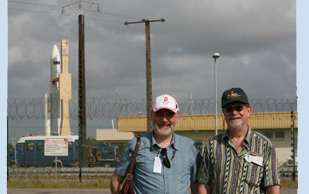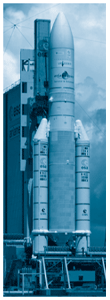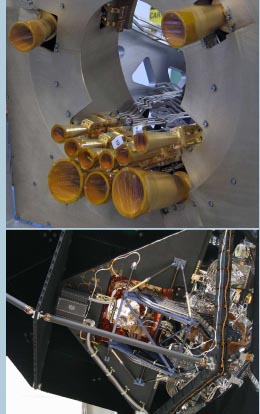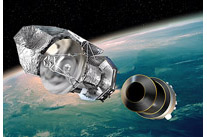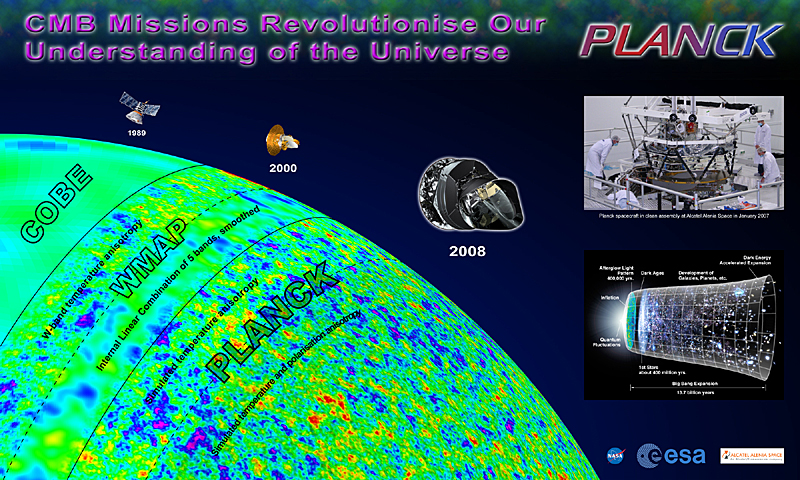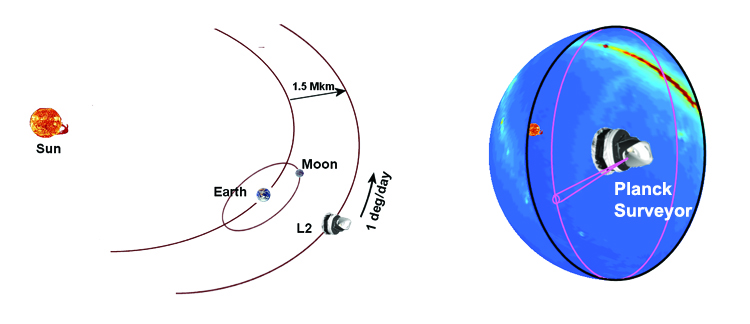
|
||
|
Planck is a European Space Agency (ESA) mission that will provide answers to some of the most important questions in modern science - how did the universe begin, how did it evolve to the state we observe today, and how will it continue to evolve in the future? Planck's objective is to analyze, with the highest accuracy ever achieved, the remnants of the radiation that filled the universe immediately after the Big Bang, which we observe today as the Cosmic Microwave Background (CMB). It was launched on May 14 2009.
Even before the results of his differential microwave radiometer experiment aboard NASA’s Cosmic Microwave Background Explorer (COBE) had been announced, George Smoot of Berkeley Lab’s Physics Division was eager to launch a space mission that could definitively explore the cosmic microwave background (CMB). Read more here.
Planck History In 1992, George Smoot, Reno Mandolesi, and Marco Bersanelli began work on the original COBRAS proposal (COsmic Background Radiation Anisotropy Satellite) that became the Planck Surveyor. Dr. Smoot has been involved with Planck since its inception, and is a senior member of the project along with Martin White. Smoot will be present for the launch on Thursday, May 14, at 6:12 a.m. Pacific Daylight Time at the Guiana Space Center. Julian Borrill, Christopher Cantalupo, Sara Ricciardi, Fredrico Stivoli, and Carlo Baccigalupi are all members of the data analysis team.
|
||
|
Herschel and Planck in the fairing and attached to the Ariane V launcher.
A Launch for Science May, 2009 For its second launch of the year, Arianespace will orbit two scientific satellites for the European Space Agency: the Herschel space telescope and the Planck scientific observatory. This is the only launch vehicle on the commercial market today capable of launching two payloads simultaneously, and handling a complete array of missions, from commercial launches into geostationary orbit, to scientific missions into special orbits. The launcher will be carrying a total payload of 6,001 kg, including 5,322 kg for the two satellites,which will be released separately into their targeted orbit. The launch will be from Kourou, French Guiana. The Herschel space telescope and the Planck scientific observatory were both built by Thales Alenia Space. Read more about launch logistics in this PDF.
The Planck-LFI Programme This paper provides an overview of the Low Frequency Instrument (LFI) programme within the ESA Planck mission. The LFI instrument has been developed to produce high precision maps of the microwave sky at frequencies below the peak of the Cosmic Microwave Background (CMB) radiation spectrum. LFI is the result of an active collaboration among about a hundred universities and research centres, in Europe, Canada and USA, organized in the LFI Consortium (supported by more than 300 scientists) and funded by national research and space agencies. The scientific goals of the Planck-LFI programme range from mainstream cosmology to galactic and extragalactic astrophysics. The Planck-LFI Programme PDF
Figure 9. Top panel: picture of the LFI focal plane showing the feedhorns and main frame. The central portion of the main frame is designed to provide the interface to the HFI front-end unit, where the reference loads for the LFI radiometers are located and cooled to 4K. Bottom panel: A back-view of the LFI integrated on the Planck satellite. Visible are the upper sections of the waveguides interfacing the front-end unit, as well as the mechanical support structure.
Planck-LFI Instrument Description This paper provides an overview of the LFI instrument, discusses the leading scientific requirements, and describes the design solutions adopted for the various hardware subsystems. The main drivers of the radiometric, optical and thermal design are discussed, including the stringent requirements on sensitivity, stability, and rejection of systematic effects. PDF
BBC News Telescope 'Cousins' Meet at Last
Planck Follows Herschel to Launch Site
Herschel, ESA's cutting-edge space observatory, will carry the largest, most powerful infrared telescope ever flown in space. A pioneering mission to study the origin and evolution of stars and galaxies, it will help understand how the Universe came to be what it is today. Herschel will tap into unexploited wavelengths, seeing phenomena out of reach for other observatories, at a level of detail that has not been captured before. The telescope will collect almost twenty times more light than any previous infrared space telescope. Read more from the ESA Herschel page.
More ESA images and animations __________________________________________________________________________________
What the Planck Satellite Will See Astrophysicist Julian Borrill of the Computational Research Division and Berkeley Lab researchers have achieved what they say is a “significant milestone” by processing a year's worth of simulated Planck data at the single most CMB-sensitive frequency, producing a high-resolution CMB map in just two hours Read more here. Julian Borrill, Radek Stompor, and Christopher Cantalupo
Computational Cosmology Center Cosmic Microwave Background Data Analysis At NERSC __________________________________________________________________________________
In 1998 the balloon-borne BOOMERANG and MAXIMA experiments made what were then the highest-resolution measurements of minute variations in the temperature of the cosmic microwave background radiation (CMB). Their high resolution was achieved by scanning small patches of the sky to gather unprecedented volumes of data. The analysis of these datasets presented a significant computational challenge – they were the first CMB datasets to require supercomputing resources. Read more here. _________________________________________________________________________________
BBC News Report - Satellite prepares to go super-cold by Paul Rincon
Full size poster PDF
|

 Watch the Launch
Watch the Launch 